The BMC Tells You Where to Die
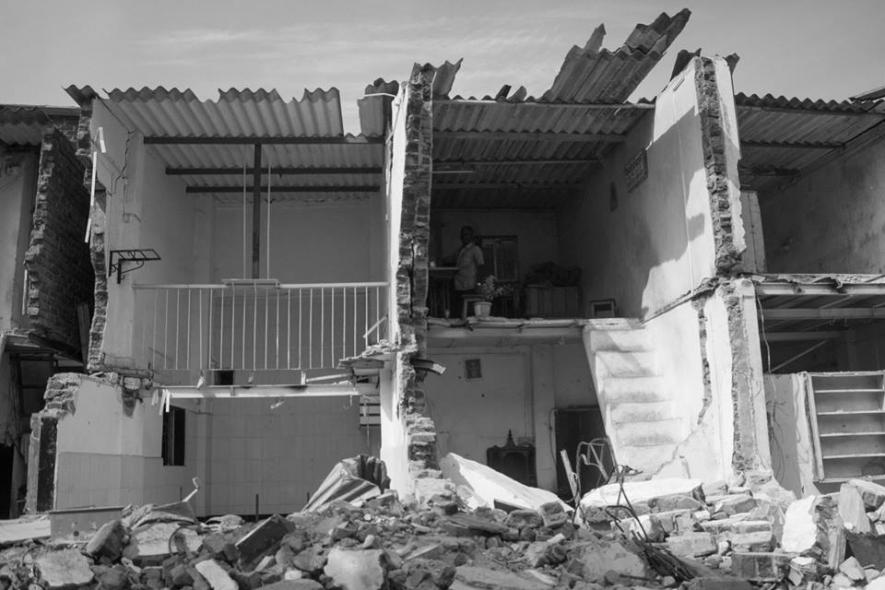
Image Courtesy: Prthvir Solanki
Selvi, and 15 other women from the Indiranagar slum in Vakola, found themselves in police custody on the afternoon of 14th November. The reason: they held an impromptu morcha in front of the BMC bulldozers which were indiscriminately and brutally demolishing their homes. They were dragged by the hair, beaten with sticks and thrown into the lock-up. They remained there for two days.
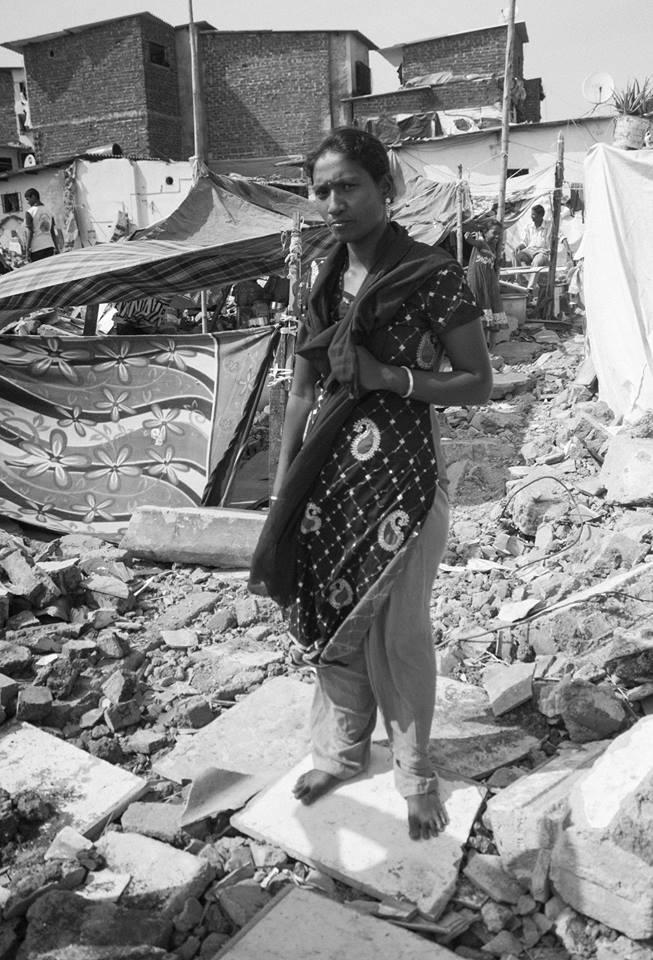
Selvi is finding it difficult to find work after the demolition because of which she hasn’t earned the money to pay her children’s school fees
In those two days, the BMC razed around 450 homes that have stood for the last three decades, giving little or no time to the residents to collect their belongings. TV sets, important documents, children’s toys, all of it now lies broken or buried under the rubble. This, despite the fact that on the 13th of November, residents here received a stay order from the Bombay High Court halting any demolition activity that was planned.
“I was returning from work that afternoon and came back only to see my home demolished. How could I sit there quietly?” said Selvi as she recounted the events of that day to me. She worked as a domestic help in numerous households in the Kalina region, but is now being barred from entering homes after news of her two nights in lock-up somehow spread. “Now I don’t even have money to pay for my children’s school fees, so they’re also stuck here.” ‘Here’ is now an undefined land-space in what remains of Indiranagar. She, along with hundreds of others, spend their nights in the cold and days in the heat, afraid to begin rebuilding their homes in case the BMC comes to demolish them again.
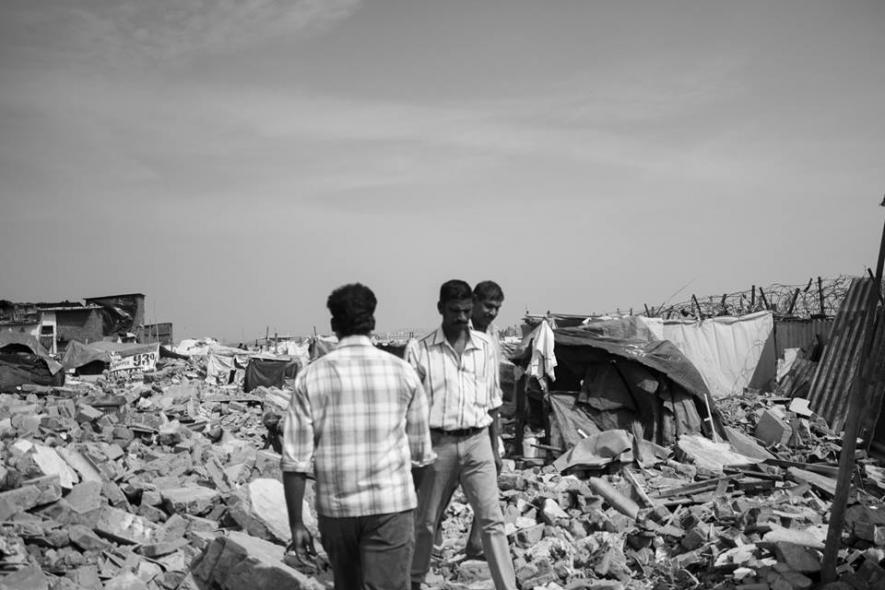
Indiranagar lies just outside the border of the airport
The demolition at Indiranagar is one of many that have already taken place along the Tansa Pipeline. In 2006, a PIL was submitted by the Janhit Manch, an NGO fighting for ‘good governance’ out of Mumbai, regarding the safety of the pipeline and how the water is at risk of contamination because of the ‘encroachers’ living around it. Following this, in 2009 the High Court directed the BMC to begin razing homes, legal and illegal, that fall within 10m on either side of it, which included areas in Khar, Ghatkopar, Bandra, Bhandup and here in Vakola. Those whose homes were deemed ‘eligible’ in the Slum Rehabilitation Authority’s (SRA) annexure II list would be allotted alternate homes in Mahul.

Mahul has, however, proven to be a veritable gas-chamber. Situated in the midst of twelve chemical factories, residents complain of the high pollution in the area affecting their health in disastrous ways. This is separate from the fact that Mahul is situated kilometres away from any source of livelihood, with little or no means of public transport and no municipal schools to study at. It is no wonder that those allotted homes there refuse to move.
“Why should we go there? It’s far away from where we earn money, there are no schools there, no hospitals there, there are water issues there. None of that affects us here.” Sengha Kottabadi has lived here for longer than she can remember. She spent 4-5 lakh to build her two-floor brick structure, which took about 20 minutes to flatten. She was one of the 120 ‘eligible’ candidates in Indiranagar to have been allotted a room in Mahul. “We are not against the government taking away our homes, but they should at least rehabilitate us properly.”

Vinod Nadar is constantly on the phone since the demolition, trying to mobilize support and create a plan of actiongoing ahead
However, the manner in which the BMC seem to be going about demolishing these homes reeks of a lack of respect and empathy for the people living here. Vinod Nadar, who runs his internet business from here, tells me that despite getting a stay order from the High Court, the authorities did not back down and continued to demolish the homes.
“On 13th November, we received a stay order in the evening, citing that the area given to us for rehabilitation was not adequate. On 14th, we went to meet the Assistant Municipal Commissioner of the ward, Alka Sasane, to talk about this. However, she ignored us and went to give the orders for the demolition instead. We showed her the High Court order, to which she responded saying that she’ll do what she has to do, we can continue to do what we want to, but our homes will be demolished.” Nadar said he begged, pleaded and cried, but was thrown into the Vakola Police Station lock-up with other residents.
Further, there seem to be discrepancies in the annexure II list put out by the SRA. Despite many residents submitting the required paperwork to prove their eligibility (residents need to prove that they lived in the area before 2000), their names appeared under the ‘apatra’ or ineligible category. No reasons have been provided for the same.
***
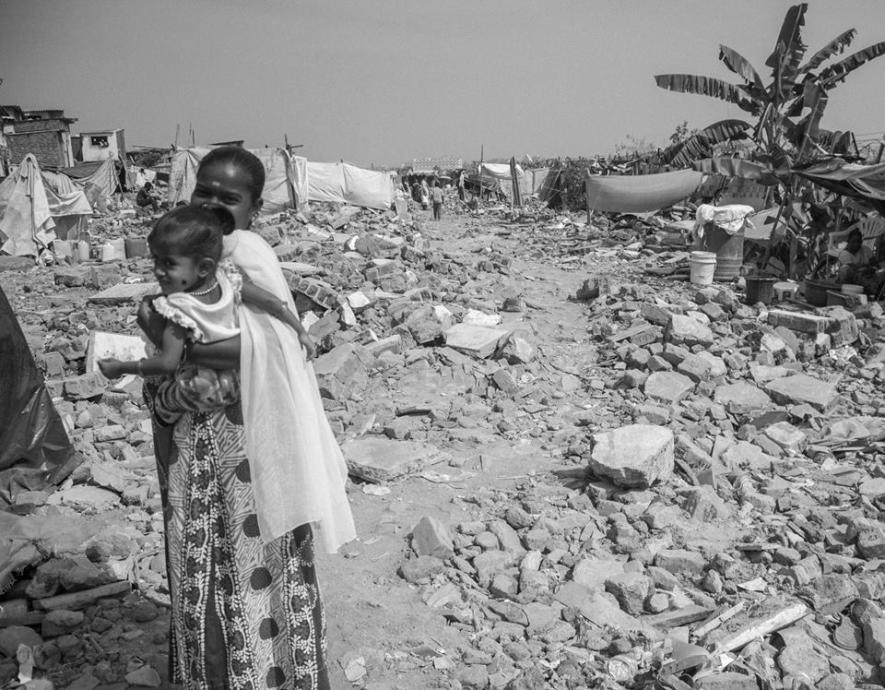
The single path that connected the end of the slum to the beginning is now rubble. “This used to be where we would carry our dead bodies too,” as one resident said to me. Now it’s difficult to walk without the risk of falling onto a sharp rock
Indiranagar is located behind the massive Grand Hyatt property in Santa Cruz, existing precariously at the border of the International Airport. Conversations are punctured with the loud sounds of flights taking-off and landing. I have to apologise and stop myself each time I hear the first note of the loud airplane sound “You can continue, we can hear you”, laughs a resident, “We’re used to it now, it’s embedded in our DNA.”
The area has a majority-Dalit population hailing from Tamil Nadu. Most are employed in sanitation jobs for the BMC, while others work as domestic help, drivers, watchmen and other jobs that keep the city and its rich afloat.
A lot of their livelihood is dependent on the geographical location in which they are situated. Living here for more than three decades now, a sudden shift to anywhere else would be akin to restarting their lives. The other dangers of Mahul are also now well-known.

After shifting from Dharavi to Indiranagar in 2004, Ashok Arjan’s pre-2000 documents were lost. Now he is having a hard time proving his eligibility, despite having a ration card dating back to the 1980s. Here he shows me the pipe's vent behind the wall.
“Our homes are within 10 metres of the pipe, we are not contesting that. But so is Grand Hyatt. So are parts of the airport. Are the people who work there or the residents who live there not a danger to the pipe?” asks Vinod.
Regardless of the 2009 order, there anyway exists a high wall topped with abundant amounts of barbed wire to separate the slum from the pipe. The pipe, as it turns out, is also underground. If ‘protecting’ was the idea behind the demolition, the wall and the earth should have sufficed.
Maharashtra Chief Minister Devendra Fadnavis has also announced the construction of a 39-km jogging track along the length of the Tansa Pipeline. The BMC is using all of its might to evict citizens from their homes to allow a few muscles to be relaxed.
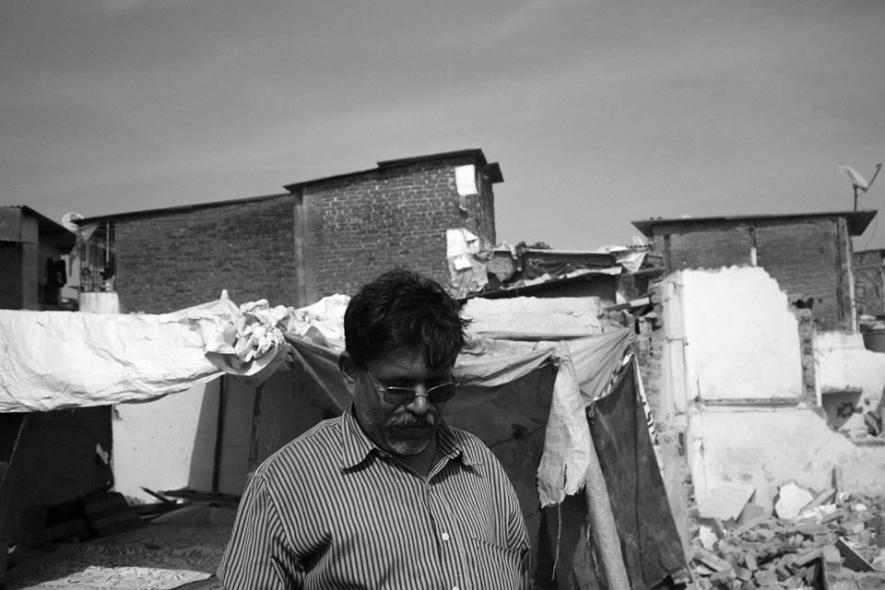
Baburao Shellar standing at the border between what was demolished and what was just beyond the 10 metre mark
“Why did the pipe suddenly become a problem now? Why did they provide us with water connections and electricity connections for the last so many years if we were a ‘threat’?” asks Baburao Shellar. “We’ve been here for so many years, has there ever been any untoward incident? Even if we were to prick a hole into the pipe to contaminate it, the force of the water that would escape would be enough to blow anyone nearby away.”
The residents, however, know little about the jogging track.
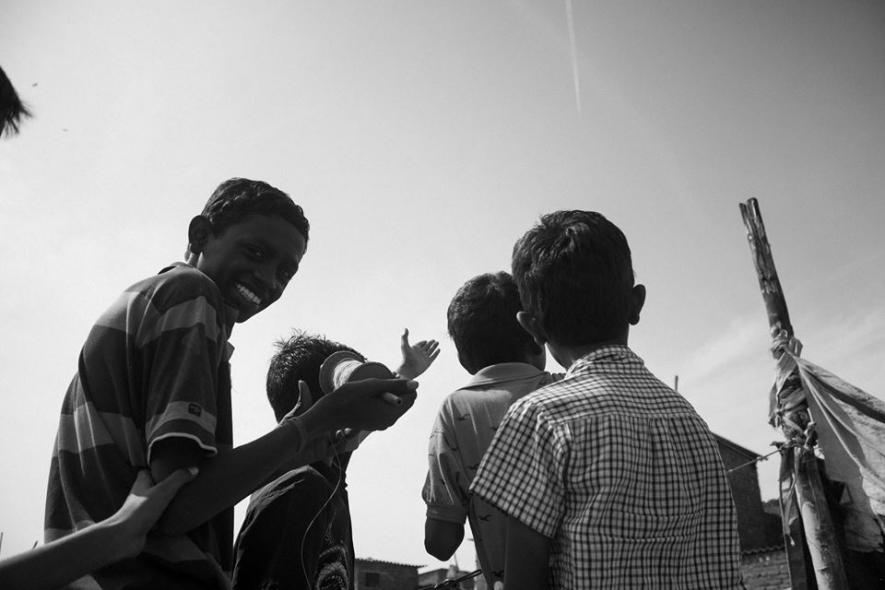
The bulldozers couldn't crush the kites
The aggression with which the BMC is going about clearing these spaces is baffling considering that it is a jogging track that is at stake. In fact, residents claim, when the Airport Authority of India ordered for part of Indiranagar to be razed a few years ago, on the behest of Shiv Sena MP Sanjay Raut, the people resisted and saved their homes. There were no bulldozers then, no violence and no confounding paperwork.
This time however, in the name of this jogging track and ‘protecting the pipe’, not only are people being uprooted from their homes and livelihoods, but are also being shifted to the controversial MMRDA Rehabilitation complex in Mahul. As Shellar says to me, if they want so badly for them to die, then they’d rather die here where their homes are.
***
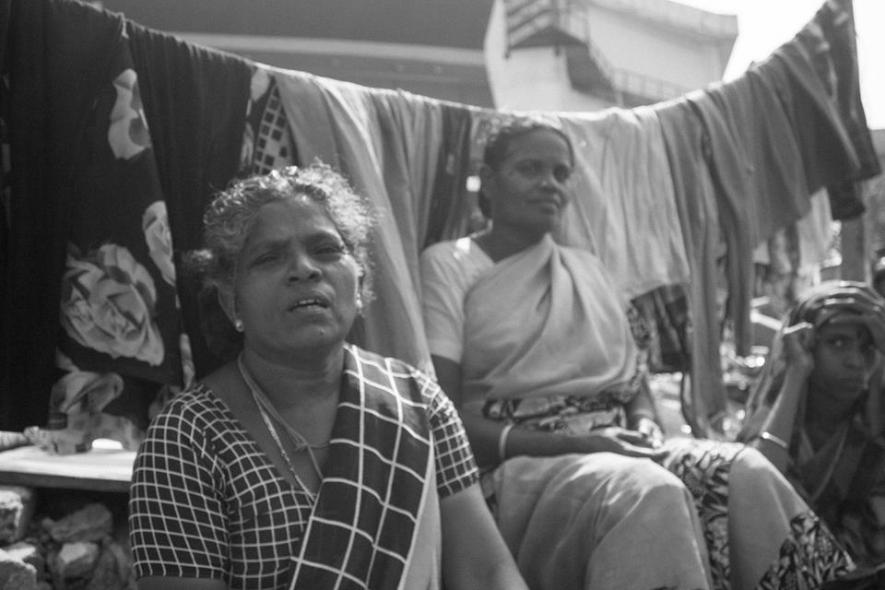
Sengha Kottabadi was one of the first women to begin the morcha against the BMC on the 14th. She had not known then that her home too would be demolished
Kottabadi takes me to a group of women who work as sanitation workers for the BMC and who have lived here for more than 25 years.
They are all visibly angry, but break into laughs whenever a sarcastic comment is made.
“We are the ones who have protected the airport all these years, we have protected the pipeline all these years, and now suddenly they’re calling us a threat?” says Alakamma.
She continues, “Last week, Poonam Mahajan was just opposite the slum to open a new temple in the area. She could have come to see us here, offer some help to us. But she was more interested in the temple than looking out for us.”
The state of our times, summed up.

This boy demanded I take his photo and ran off to play with his friends immediately after I did
Disclaimer: The views expressed here are the author's personal views, and do not necessarily represent the views of Newsclick.
Get the latest reports & analysis with people's perspective on Protests, movements & deep analytical videos, discussions of the current affairs in your Telegram app. Subscribe to NewsClick's Telegram channel & get Real-Time updates on stories, as they get published on our website.
























